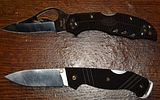
A shot of the ZB 786 alongside the Byrd Meadowlark :

This review consists of :
The SRM ZB 786 is a small folding back lock with a thumbstud :
The edge is 0.015" thick and 0.030" wide which gives an edge angle of 14 (1) degrees per side.
 The initial sharpness was decent. The
ZB 786 can slice newsprint and scrape shave a
little, but is very aggressive on a slice, and
slices light jute under 500 grams
of tension with less than 0.5 cm of edge. A check under 50X magnification
(picture on the right)
explains the performance. The edge was ground with a very coarse abrasive and
then hit with a buffer. The white spots are the micro-serrations left by the
rough abrasive. A few passes on unloaded leather (10 passes per side) and the
knife would now push cut newsprint, shave, and slice the jute with less than
0.25 cm of edge, pretty much the same sharpness on a new Spyderco / Cold Steel
knife.
The initial sharpness was decent. The
ZB 786 can slice newsprint and scrape shave a
little, but is very aggressive on a slice, and
slices light jute under 500 grams
of tension with less than 0.5 cm of edge. A check under 50X magnification
(picture on the right)
explains the performance. The edge was ground with a very coarse abrasive and
then hit with a buffer. The white spots are the micro-serrations left by the
rough abrasive. A few passes on unloaded leather (10 passes per side) and the
knife would now push cut newsprint, shave, and slice the jute with less than
0.25 cm of edge, pretty much the same sharpness on a new Spyderco / Cold Steel
knife.
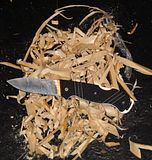 To get a feel for the cutting ability of the ZB 786,
a piece of fresh alder was carved into a piled of shavings.
Alder is a very soft wood, usually softer than pine and when dry
makes a very nice kindling as it burns very fast and hot.
This small folder cuts very well as expected given the full
flat grind and thin and acute edge. As the wood is so
soft it was easily cut with light force and there were no issues.
The knife could easily make thin shavings easily and simply by
changing the angle slice very deeply and work heavy pieces off
of the wood.
But a different experience was had when doing the same work on some
hardwood when much more force had to be used to cut the wood
as it was simply much more dense.
Again the cutting ability was solid.
In terms of number of cuts necessary, the ZB 786
compared very well to a
Mora #1260
but there was no comparison in terms of the ergonomics.
The Mora had a nice filling grip which was comfortable
in any orientation but the ZB 786
pokes and prods any full grip and has a high rate of fatigue
as it is uncomfortable and also provides just a three finger
grip. This is obviously meant to be a small light
use folder of course, but there are lots of small folders which can
work in heavy grip.
To get a feel for the cutting ability of the ZB 786,
a piece of fresh alder was carved into a piled of shavings.
Alder is a very soft wood, usually softer than pine and when dry
makes a very nice kindling as it burns very fast and hot.
This small folder cuts very well as expected given the full
flat grind and thin and acute edge. As the wood is so
soft it was easily cut with light force and there were no issues.
The knife could easily make thin shavings easily and simply by
changing the angle slice very deeply and work heavy pieces off
of the wood.
But a different experience was had when doing the same work on some
hardwood when much more force had to be used to cut the wood
as it was simply much more dense.
Again the cutting ability was solid.
In terms of number of cuts necessary, the ZB 786
compared very well to a
Mora #1260
but there was no comparison in terms of the ergonomics.
The Mora had a nice filling grip which was comfortable
in any orientation but the ZB 786
pokes and prods any full grip and has a high rate of fatigue
as it is uncomfortable and also provides just a three finger
grip. This is obviously meant to be a small light
use folder of course, but there are lots of small folders which can
work in heavy grip.
 An assortment of materials cut to check the edge for any major defects, from
left to right :
An assortment of materials cut to check the edge for any major defects, from
left to right :
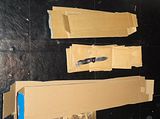 Slicing up some cardboard, again the slim stock and thin and acute edge
zips through cardboard and the narrow blade easily
turns in the cardboard. A couple more details :
Slicing up some cardboard, again the slim stock and thin and acute edge
zips through cardboard and the narrow blade easily
turns in the cardboard. A couple more details :
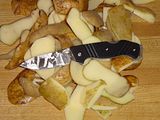 In the kitchen
compared to an actual paring knife it is significantly behind, but
the force is still minimal. The ZB 786 takes a few pounds to make a cut
through a carrot and a optimal ground paring knife is less than a pound.
But compared to other folders, this knife does very well and the
slim blade allows it to turn well so it can peel a potato much easier
than a wider blade like a Manix for example. Using it on :
In the kitchen
compared to an actual paring knife it is significantly behind, but
the force is still minimal. The ZB 786 takes a few pounds to make a cut
through a carrot and a optimal ground paring knife is less than a pound.
But compared to other folders, this knife does very well and the
slim blade allows it to turn well so it can peel a potato much easier
than a wider blade like a Manix for example. Using it on :
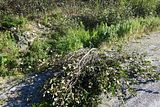 Using the
ZB 786 for heavier work
it was used to clean up a section of ditch which contained
light brush, alders, some young pine and of course grasses
and light brush.
Of course the ideal tools for this work are
Using the
ZB 786 for heavier work
it was used to clean up a section of ditch which contained
light brush, alders, some young pine and of course grasses
and light brush.
Of course the ideal tools for this work are
 When the brush was cut and the thicker wood separated out
then the knife was used to break down the wood and remove all the
limbs.
With heavy cuts, 50-75 lbs of force applied,
using sweeping motions athe
folder would clear the small branches easily.
The larger branches had to be sliced off individually.
This was no problem as the knife cuts well
but again the Junglas was many to one times faster and can sweep an
entire side of a stick clean while the ZB 786 is cutting off one
of the thicker limbs.
But with either knife fatigue was not really an issue and again the
only real issue with the folder was
the small handle on the folder which gets abrasive with extended use.
But in any case a decent amount of wood was cut and processed, hundreds of
heavy slices, no lock play.
A full size folder would of course be preferred but this was
much easier with the small knife than bare handed.
When the brush was cut and the thicker wood separated out
then the knife was used to break down the wood and remove all the
limbs.
With heavy cuts, 50-75 lbs of force applied,
using sweeping motions athe
folder would clear the small branches easily.
The larger branches had to be sliced off individually.
This was no problem as the knife cuts well
but again the Junglas was many to one times faster and can sweep an
entire side of a stick clean while the ZB 786 is cutting off one
of the thicker limbs.
But with either knife fatigue was not really an issue and again the
only real issue with the folder was
the small handle on the folder which gets abrasive with extended use.
But in any case a decent amount of wood was cut and processed, hundreds of
heavy slices, no lock play.
A full size folder would of course be preferred but this was
much easier with the small knife than bare handed.
The ZB 786 was also used to cut the wood to length using a small makeshift mallet as shown in the video on the right. It was used for about an hour cutting up all the sticks to foot long lengths for fuel. Here are a few critical points to keep in mind which allowed this work to be done with minimal stress on the lock :
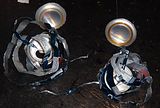 An interesting point of comparison for this blade is
the Byrd line.
The main difference is that the Byrd line is
hardened to 61 HRC and the Sanrenmu is spec'ed at 57-58. Is the
difference enough to notice doing some
basic cutting, and measuring sharpness in some very
straightforward
ways
when both blades
are at the same angle of 14-15 degrees per side with a fine DMT
finish? To start :
An interesting point of comparison for this blade is
the Byrd line.
The main difference is that the Byrd line is
hardened to 61 HRC and the Sanrenmu is spec'ed at 57-58. Is the
difference enough to notice doing some
basic cutting, and measuring sharpness in some very
straightforward
ways
when both blades
are at the same angle of 14-15 degrees per side with a fine DMT
finish? To start :
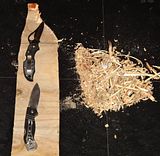 Switching to some harder to cut material, both knives were used to
Switching to some harder to cut material, both knives were used to
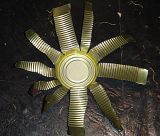 As an attempt to see if the steels could be separated in performance
if a bit more precision was used to measure the
difference between them a food can was cut with each blade with the intent
to check the edges under magnification :
As an attempt to see if the steels could be separated in performance
if a bit more precision was used to measure the
difference between them a food can was cut with each blade with the intent
to check the edges under magnification :
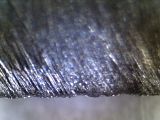
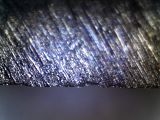 Under 50X magnification as shown on the right
there is no significant difference seen.
Note the section in the pictures is the most heavily damaged
section of edge.
The majority of the edge
had damage less than half shown
and about 25 percent was undamaged at 50X magnification.
Note that this isn't chipping, it is both direct wear and flattening, again
this would be expected in this steel as it is a medium carbon,
low carbide stainless so has a high edge stability.
Both blade are restored to a push cutting edge on newsprint
with just a few minutes on a small DMT dual/pad.
Under 50X magnification as shown on the right
there is no significant difference seen.
Note the section in the pictures is the most heavily damaged
section of edge.
The majority of the edge
had damage less than half shown
and about 25 percent was undamaged at 50X magnification.
Note that this isn't chipping, it is both direct wear and flattening, again
this would be expected in this steel as it is a medium carbon,
low carbide stainless so has a high edge stability.
Both blade are restored to a push cutting edge on newsprint
with just a few minutes on a small DMT dual/pad.
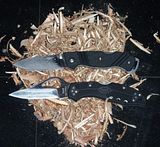 As a final extreme check
the edge on both knives was reground to a very acute profile.
The Sanrenmu was brought down to 6.8 (5) degrees per side
and the Byrd to 7.3 (5) degrees per side (both had a very light microbevel due
to rounding of the stone in sharpening). With these new very acute grinds
the knives were used to :
As a final extreme check
the edge on both knives was reground to a very acute profile.
The Sanrenmu was brought down to 6.8 (5) degrees per side
and the Byrd to 7.3 (5) degrees per side (both had a very light microbevel due
to rounding of the stone in sharpening). With these new very acute grinds
the knives were used to :
Comments can be emailed to Knife Review : ZB 786
Most of the pictures in the above are in the ZB 786
album at PhotoBucket.
| Last updated : | 11:29:2011 |
| Originally written: | 11:29:2011 |